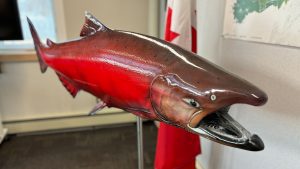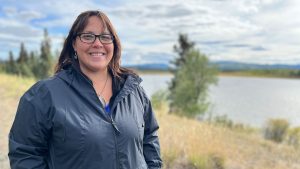A First Nation in Yukon is celebrating a new chinook salmon management agreement between Canada and the U.S.
On Apr. 1, the Alaska Fish and Game and Fisheries and Oceans Canada (DFO) signed an agreement to rebuild chinook salmon stocks.
The agreement places a moratorium on commercial, sport, domestic and personal fishing. The moratorium will be in place for seven years, which is the full life cycle of a chinook salmon. It will remain in effect from April 2024 to 2030.
Chief Nicole Tom of the Little Salmon/Carmacks First Nation (LSCFN) told APTN News she welcomed the agreement, describing it as “monumental.”
“I think that it’s a great agreement. I think that it’s been long waited for,” she said.
The agreement’s goal is for 71,000 fish to make it to their spawning grounds in Canada. The U.S. and Canada have a minimum goal to get 42,500 fish across the border.
But in recent years, that goal has not been met. In 2023, just over 15,000 fish were counted by sonar at the Alaskan-Yukon border.
While there’s no definitive answer as to why stocks are depleting, overfishing, competition from hatchery fish, habitat degradation and the effects of climate change have been linked as causes of their decline.
Steve Gotch, senior director for DFO’s Pacific region, said the last time 71,000 Canadian-origin fish were counted was around seven years ago.
He noted the agreement is an important step to rebuilding plummeting chinook stocks.
“It was just over one salmon lifecycle logo where we did see an abundance of that nature,” he said. “So it gives us confidence that seven years into the future, it’s not out of the realm of possibility to see chinook salmon numbers rebound.”
Tim Gerberding, executive director of the Yukon Salmon Sub-Committee, described the agreement as a “huge step forward.”
Gerberding said the moratorium on fishing was pushed by self-governing First Nations in the territory, which have a major say when it comes to salmon management.
“We’ve got to put salmon first,” he said. “I think that’s been the rallying cry of the Yukon First Nations. We’ve got to put salmon first. That means put salmon above our own needs, and that’s the only way we’re going to save them.”
‘This is a good thing’

Like other First Nations in the territory, LSCFN citizens largely refrain from harvesting chinook in an effort for stocks to rebound.
Tom said the focus now will be helping her people understand the agreement and its impacts. That will include monthly meetings solely focused on salmon.
“It’s essentially the same thing that we’ve been doing for a long time,” she explained.
“Our Dan ki, or traditional ways of knowing, we know that when something’s depleting or going extinct, we leave it alone. We let it be. And so that’s what we’re doing right now. We’re leaving it alone and giving it the opportunity to repopulate,” she said.

The agreement also provides limited opportunities for harvesting. If the number of fish is expected to exceed 71,000, both countries can consider providing limited subsistence fishing opportunities.
The U.S. and Canada will also have the discretion to provide limited harvest opportunities for cultural and ceremonial use.
Other focuses of the agreement include a priority on stock assessment and on scientific research, incorporating traditional knowledge and reducing bycatch.
Tom said she’s hopeful there will one day be plentiful salmon for future generations to enjoy.
“This is a good thing. I think that the Yukon really needs to celebrate this.”









